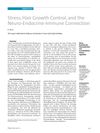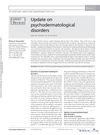Neuroimmunomodulation in Chronic Wounds: An Opinion
March 2025
in “
Frontiers in Cell and Developmental Biology
”

TLDR Improving nerve and immune interactions may help heal chronic wounds.
The document explores the role of neuroimmunomodulation in chronic wound healing, focusing on the interaction between the nervous and immune systems. It highlights the importance of cutaneous nerves and Schwann cells in maintaining epidermal stem cells in hair follicles, with denervation impairing wound re-epithelialization. Sensory nerves release Sonic Hedgehog (Shh), promoting epidermal stem cell formation. Neuropeptides like Substance P (SP) and others such as Neurokinin A (NKA), CRH, and CGRP are involved in inflammation and angiogenesis. Nitric oxide (NO) is a key mediator in the inflammatory phase, enhancing vasodilation and antibacterial activity. The document suggests that photodynamic therapy (PDT) could enhance neuroimmunomodulation, indicating potential new treatment avenues, and calls for further research to develop effective therapies.



